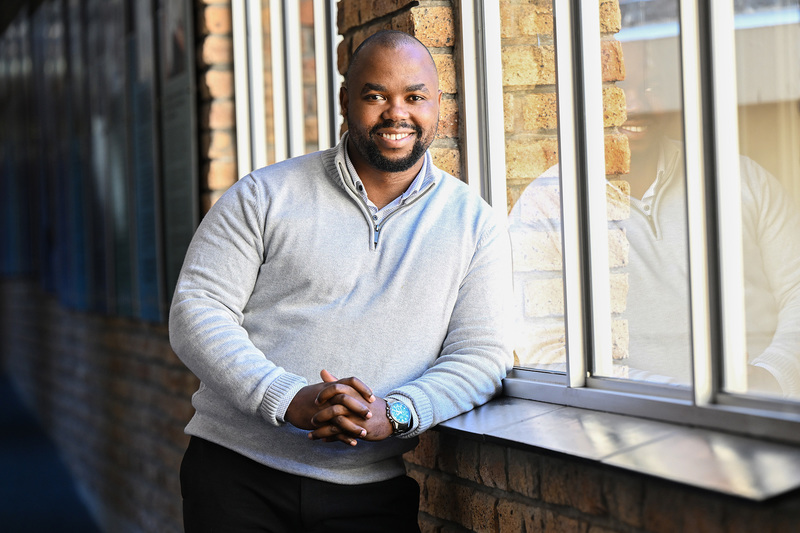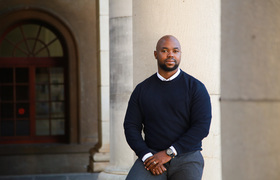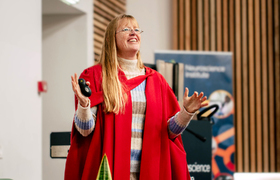Psychosocial support vital for patients undergoing lower limb amputations
20 May 2025 | Story Niémah Davids. Photo Lerato Maduna. Voice Cwenga Koyana. Read time 6 min.
Effectively managing patients who have undergone extreme lower limb amputations – the surgical removal of part or the entire leg or foot – should not just be focused on biomedical outcomes. Instead, patients need targeted interventions that provide them with purpose and agency to resume life post-amputation, including access to psychosocial support programmes that will contribute towards improving their quality of life, and help them lead full, meaningful lives despite their disability.
These results emerged in a latest research paper authored by Dr Katleho Limakatso, an honorary senior lecturer in the University of Cape Town’s (UCT) Department of Anaesthesia and Perioperative Medicine. His study filled a much-needed gap in current literature that explores patient-identified care priorities, with a focus on individuals with lower limb amputations in low- to middle-income countries like South Africa.
“With this study, we aimed to generate consensus from patients on short- and long-term care priorities after their amputations. This research was important because existing rehabilitation guidelines rarely reflect patients’ perspectives, especially in under-resourced settings,” Dr Limakatso said. “This disconnect hinders targeted treatment, recovery and reintegration into society.”
UCT News spoke to Limakatso for insight on this research study.
Niémah Davids (ND): Now that we have some background information on your research study, let us in on some of the key findings?
KL: Four key findings stand out from this research undertaking:
- Patients are in critical need of psychosocial support and education before and after an amputation.
- Patients require post-operative mental health support to help them deal with pain management and life post-amputation.
- Patients need to be equipped with skills that will help them function independently post-amputation and facilitate their reintegration into the world long-term.
- Patients need to be treated with dignity and respect and have a desire to participate in society like everyone else.
ND: Other than your key findings, are there other particularly important factors that you’d like to note that stemmed from this study?
KL: Definitely, and it’s the fact that this research once again highlights the systemic barriers amputees in South Africa face. This includes a lack of accessible transport and access to various facilities including housing. This calls for broader societal intervention alongside healthcare improvements.
ND: How important was access to information for your cohort of participants?
KL: Our findings indicate that patients with lower extremity amputations need access to information. This includes details on what the procedure entails and what they can expect post-op. This is important because they prioritise planning and rally their support systems pre-op. We’ve found that mental health, psychosocial support, as well as spiritual well-being is crucial too, especially during the first year after their amputation.
ND: From our conversation thus far it’s clear that psychosocial and mental health support are essential for patients with low extremity amputations. Why is this so?
KL: The thought of losing something that’s been part of you your whole life can be traumatic, and life as you know it will change completely.
“The thought of losing something that’s been part of you your whole life can be traumatic, and life as you know it will change completely.”
One striking finding among all participants was the deep emotional toll not being prepared for an amputation had on their lives. Some participants described seeing their amputated limb as a traumatic experience. This underscores the need for psychosocial support before and after surgery, to help patients navigate the road ahead. This is often a neglected service in under-resourced settings.
ND: Would you mind touching on the research methodology you used to solicit your findings?
KL: We used a three-round modified Delphi approach with about 20 adult participants, who are current patients at Groote Schuur Hospital – a UCT teaching hospital and one of the largest tertiary academic hospitals in the country.
Participants were all asked to identify and reach consensus on what care priorities are, and semi-structured interviews further explored their reasoning. Our participants were mainly men, unemployed and had undergone an amputation 16.5 months before we started the study.
ND: Does this research study only survey patients with lower limb amputations or those at risk of amputations as well?
KL: We honed in on patients who had undergone lower extremity amputations, and we focused on this group due to their lived experiences. After all, they are experts of their own experience and could easily articulate the kind of support they would’ve liked during their amputation journey.
ND: Did your participants have anything in common?
KL: Most participants experienced transfemoral amputations and needed this procedure due to uncontrolled diabetes, vascular disease, trauma or infection.
“With this study, we aim to build more inclusive, patient-centred guidelines that reflect actual patient needs.”
ND: Finally, what are some of the next steps now that you have concluded this work?
KL: With this study, we aim to build more inclusive, patient-centred guidelines that reflect actual patient needs. This research has already stoked interest to develop educational material to better equip patients with sufficient information regarding their patient journey. It advocates for mental health care, vocational training and spiritual support to be embedded into patients’ long-term care, especially in under-resourced settings like ours.
 This work is licensed under a Creative Commons Attribution-NoDerivatives 4.0 International License.
This work is licensed under a Creative Commons Attribution-NoDerivatives 4.0 International License.
Please view the republishing articles page for more information.










